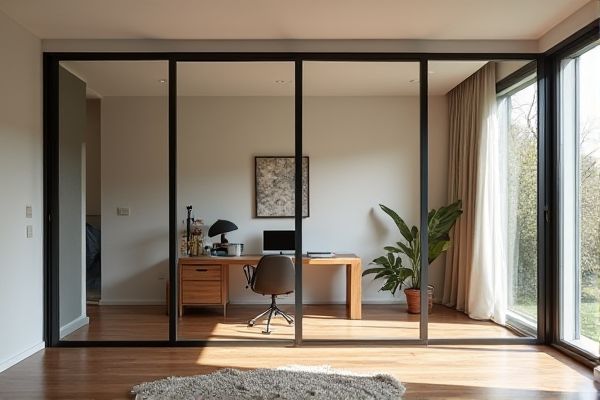
Bifold doors save space by folding neatly to one side, offering full access to study storage, while sliding doors glide silently along tracks, ideal for areas with limited clearance. Discover which option best suits your study's design and functionality needs by reading the rest of the article.
Table of Comparison
| Feature | Bifold Doors | Sliding Doors |
|---|---|---|
| Space Efficiency | Require clearance to fold outward | Slide parallel, saving floor space |
| Accessibility | Full access to storage when open | Partial access; one panel covers part of storage |
| Installation | Simple frame and track system | Requires sturdy top and bottom tracks |
| Design Options | Available in wood, glass, metal | Wide variety including mirrored and frosted glass |
| Durability | Hinges may wear over time | Tracks require regular cleaning to avoid jamming |
| Cost | Generally lower cost | Typically higher cost due to hardware |
| Ventilation | Better airflow when doors are open | Limited airflow due to sliding panels |
| Best Use | Small to medium study storage with clearance space | Compact rooms needing maximum floor space |
Introduction: Bifold vs Sliding Doors for Study Storage
Bifold doors maximize access to study storage by folding neatly to the side, allowing full visibility and easy retrieval of items. Sliding doors save space by gliding along a track without swinging out, ideal for tight or narrow study areas. Both options enhance room functionality, but bifold doors offer greater accessibility while sliding doors optimize floor space.
Space Efficiency: Comparing Door Mechanisms
Bifold doors maximize space efficiency by folding neatly against the wall, allowing full access to study storage without requiring extra clearance for door swing. Sliding doors move horizontally along a track, saving floor space but often limiting access to only one side at a time. Your choice depends on whether you prioritize complete reach or unobstructed passage in a compact study area.
Installation Complexity and Requirements
Bifold doors require precise alignment and sturdy overhead tracks for smooth operation, often demanding more complex installation compared to sliding doors. Sliding doors install on simple bottom and top tracks, making them easier to fit within existing wall cavities or surface mounts. Proper measurements and reinforcement are critical for both types to ensure durability and seamless functionality in study storage spaces.
Accessibility and Ease of Use
Bifold doors offer superior accessibility by opening fully without requiring extra space, making it easier to reach every part of your study storage quickly. Sliding doors save space by gliding along a track and are ideal for tight rooms but may limit access to only one side at a time. Your choice depends on whether you prioritize complete access or compact convenience.
Aesthetic Appeal and Design Flexibility
Bifold doors offer a sleek, contemporary aesthetic that maximizes access to study storage while creating a seamless, space-saving environment. Sliding doors provide versatile design options with smooth operation, ideal for minimalist or modern interiors where wall space is limited. Your choice depends on whether you prioritize full visibility and accessibility or a streamlined, unobtrusive look for your study storage.
Cost Considerations: Bifold vs Sliding Doors
Bifold doors generally offer a more budget-friendly option compared to sliding doors, with lower installation and hardware expenses due to their simpler mechanics. Sliding doors, while often pricier upfront, provide enhanced space efficiency and smoother operation, which may justify the investment for long-term use in a study storage area. Your choice between bifold and sliding doors should consider not only initial costs but also durability, maintenance, and how each door style complements the room's layout.
Maintenance and Durability
Bifold doors require regular maintenance to ensure smooth operation of hinges and tracks, preventing misalignment and wear over time. Sliding doors feature durable rollers and tracks designed for frequent use, but accumulating debris can impact functionality and may need periodic cleaning. Your choice should consider the ease of upkeep and the expected durability based on door materials and usage frequency.
Sound Insulation and Privacy
Bifold doors offer superior sound insulation and enhanced privacy compared to sliding doors due to their solid panel construction and tight seals that effectively minimize noise leakage. Sliding doors often have gaps along their tracks, allowing sound to pass through more easily and reducing privacy within study storage areas. Selecting bifold doors can create a quieter, more private environment, ideal for concentration and secure storage of study materials.
Customization Options for Study Spaces
Bifold doors offer versatile customization options for study storage, enabling tailored panel sizes, finishes, and hardware that fit unique spatial requirements. Sliding doors provide smooth operation and can be fitted with integrated shelves or compartments, maximizing storage efficiency while maintaining sleek aesthetics. Both door types allow for personalization to complement study decor, but bifold doors excel in compact areas where full access to storage is essential.
Conclusion: Choosing the Best Door for Study Storage
Bifold doors offer superior space efficiency and easy access, making them ideal for compact study storage areas with limited room to swing open. Sliding doors provide a sleek, modern look and seamless operation, perfect for larger studies where wall space is sufficient to accommodate the door panels. Selecting the best door depends on the study's available space, design preference, and the ease of accessing stored items.
 homyna.com
homyna.com